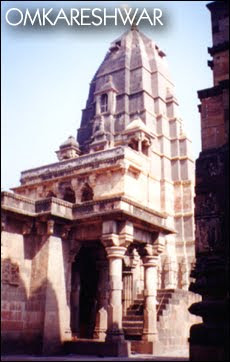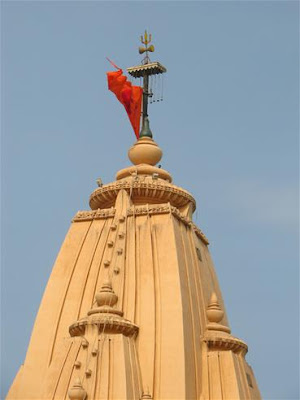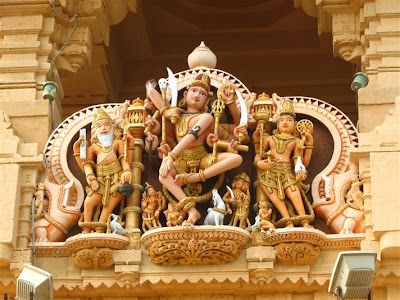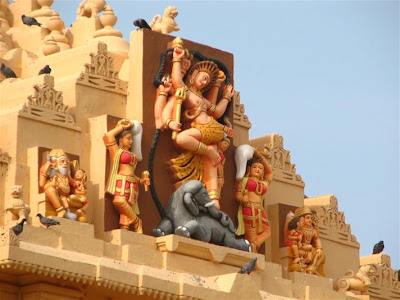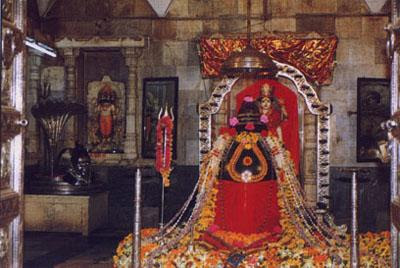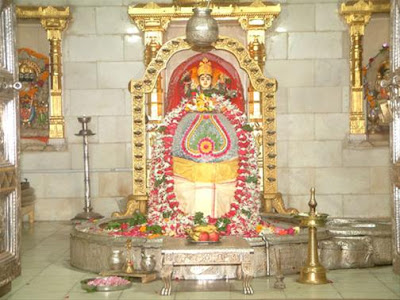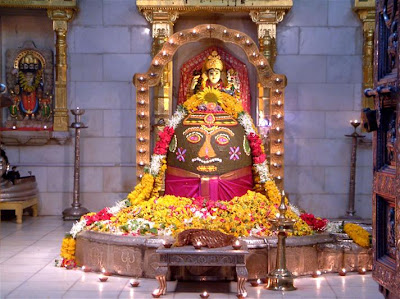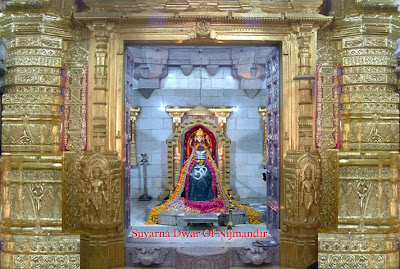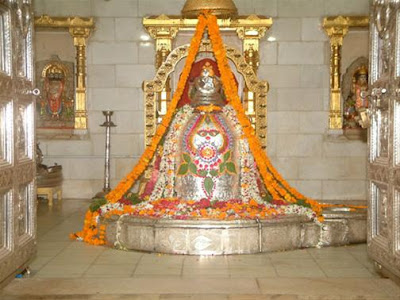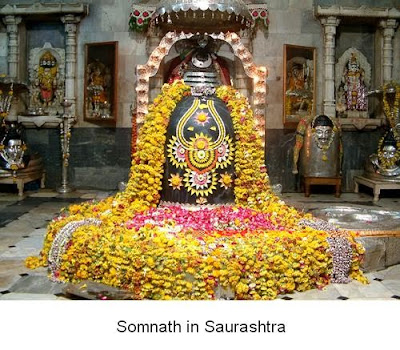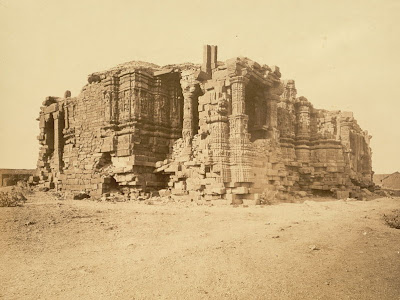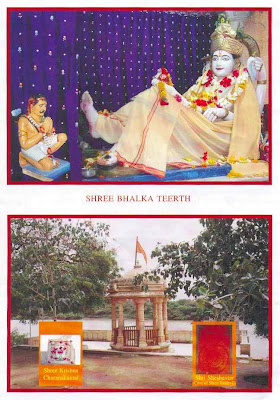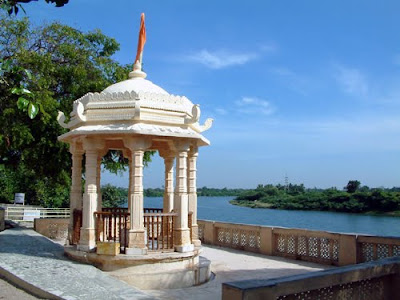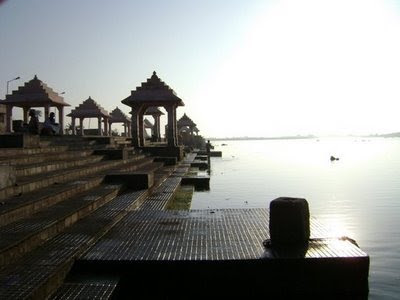| 4th Jyotirlinga-Omkareswar in Shivpuri / Mamaleswara
 This is the Imaginary map of Omkar parikrama.Omkareswar kshetra parikrama is the very important thing to do in Omkareswar tour.The parikrama route Starts from Omkareswar temple and completes after surrounding the hill.Adi Shankaracharya did parikrama when he visited Omkareswar jyotirling.While doing parikrama, he met his Guru Sri Govindapada and learned Advaita from him.We can see that place at the end of parikrama.It is nearer to Omkareswar temple. First of all we will reach Triveni sangamam.Here we can take holy bath.Just after Triveni sangamam there is a temple of Runa Mukteswar. In this temple people offer Red gram to lord Siva. After that the journey is through forest.It is very pleasent and nice to see in Winter season.After crossing this forest there is a temple of Bholenath.It is the mid point of parikrama. The Shiva linga in this temple is very big and it is made of Narmada banam.After that we will reach Durga Goddess temple. By crossing Durga temple one will enter into a deep forest.In the forest there are many ancient monuments and temples which are under the control of Indian Archeological department.In the way of Parkrama we can see so many Sadhus belonging to different traditions.If we are lucky we can see deers and peacocks in the route.The view of Narmada river is very beautiful with the bridges and the Project.The last stop is the cave of Guru Govindapada in this parikrama . This is the Imaginary map of Omkar parikrama.Omkareswar kshetra parikrama is the very important thing to do in Omkareswar tour.The parikrama route Starts from Omkareswar temple and completes after surrounding the hill.Adi Shankaracharya did parikrama when he visited Omkareswar jyotirling.While doing parikrama, he met his Guru Sri Govindapada and learned Advaita from him.We can see that place at the end of parikrama.It is nearer to Omkareswar temple. First of all we will reach Triveni sangamam.Here we can take holy bath.Just after Triveni sangamam there is a temple of Runa Mukteswar. In this temple people offer Red gram to lord Siva. After that the journey is through forest.It is very pleasent and nice to see in Winter season.After crossing this forest there is a temple of Bholenath.It is the mid point of parikrama. The Shiva linga in this temple is very big and it is made of Narmada banam.After that we will reach Durga Goddess temple. By crossing Durga temple one will enter into a deep forest.In the forest there are many ancient monuments and temples which are under the control of Indian Archeological department.In the way of Parkrama we can see so many Sadhus belonging to different traditions.If we are lucky we can see deers and peacocks in the route.The view of Narmada river is very beautiful with the bridges and the Project.The last stop is the cave of Guru Govindapada in this parikrama .Mandhata was a great Emperor of the Ikshvaku clan who ruled this land. He did great penance in this land & there is an ashram called Mandhata ashram here. It is told that he built 108 temples around Omkareshwar. 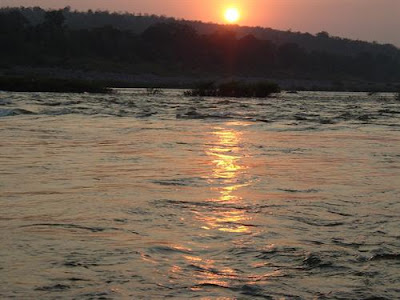 River Narmada flows here around the Mandhata hill in the form of an Om (Omkaram). The above picture is of Narmada and kaveri sangam at sunset River Narmada flows here around the Mandhata hill in the form of an Om (Omkaram). The above picture is of Narmada and kaveri sangam at sunset An interesting idol of Lord Ganesh in Madhya Pradesh An interesting idol of Lord Ganesh in Madhya Pradesh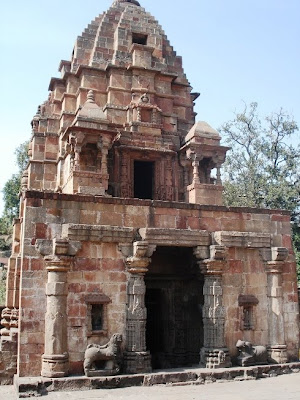 An old temple near Omkareshwar An old temple near Omkareshwar  The cave where Adi Shankaracharya ji received Diksha from Govind Bagvad pada 2000 yrs ago The cave where Adi Shankaracharya ji received Diksha from Govind Bagvad pada 2000 yrs ago Hanumaan temple near Omkareshwar Hanumaan temple near Omkareshwar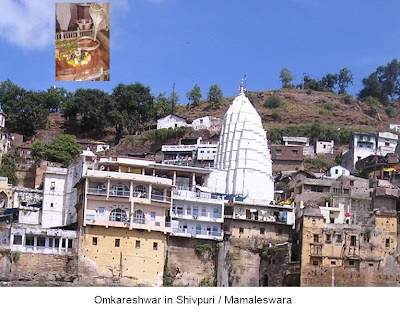  This Jyotirlinga is situated by the banks of Narmada river in the Malva area. Gods of all the Gods Lord Shiva's Omkareshwar linga is situated on the mountain Mandhata. The Shiv Purana speaks of the greatness of Omkareshwar and Mammaleshwar. The 2 sons of the sun dynasty Mandhata (Ambarish and Mucchkund), practiced severe penance and austerities here pleased Lord Shiva. They had also performed great religious sacrifices here, because of this the mountain is named Mandhata.Before entering the temple one has to pass through 2 rooms. This Jyotirlinga is situated by the banks of Narmada river in the Malva area. Gods of all the Gods Lord Shiva's Omkareshwar linga is situated on the mountain Mandhata. The Shiv Purana speaks of the greatness of Omkareshwar and Mammaleshwar. The 2 sons of the sun dynasty Mandhata (Ambarish and Mucchkund), practiced severe penance and austerities here pleased Lord Shiva. They had also performed great religious sacrifices here, because of this the mountain is named Mandhata.Before entering the temple one has to pass through 2 rooms. Amongst the 12 Jyotirlingas Omkareshwar is undoubtedly considered but another name which often comes in this context is Mammaleshwar. Not only the name but the existence of these two are also thoroughly different. The temple of Maleshwar is situated south of the river Narmada, but both the forms of Shiva have been counted as one. Amongst the 12 Jyotirlingas Omkareshwar is undoubtedly considered but another name which often comes in this context is Mammaleshwar. Not only the name but the existence of these two are also thoroughly different. The temple of Maleshwar is situated south of the river Narmada, but both the forms of Shiva have been counted as one.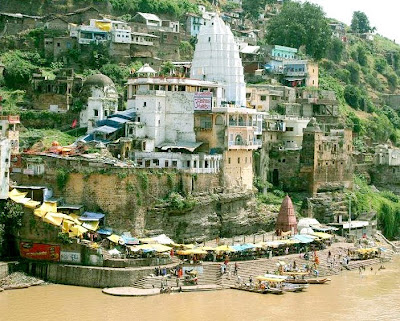 The Omkareshawar temple is built in the North Inidan style of architecture, with high spires. Devotees consider worship to Panchamuga Ganesha, to be very auspicious. There is a shrine for Annapoorani. Siva Lingas of various sizes are sold in great numbers in this place. The Omkareshawar temple is built in the North Inidan style of architecture, with high spires. Devotees consider worship to Panchamuga Ganesha, to be very auspicious. There is a shrine for Annapoorani. Siva Lingas of various sizes are sold in great numbers in this place.Once upon a time Narada visited Vindhya parvatha.Vindhya gave Narada a warm welcome and asked about world as Narada used to continuosly visit all the important places. Narada sighed deeply. Vindhya asked what was the reason. Narada replied that though all the Mountains were credited with their own special features, Meru was proud of his possessions and was boasting of his greatness. After telling all this to Vindhya , Narada left without a word . Vindhya was annoyed with this dicussion and felt jealous about meru and wanted to become greater than Meru.Then Vindhya did a great penance for Lord Shiva for his desire.Lord Shiva blessed him & appeared here as Omkareshwar & (Mamaleshwar)Amaleshwara and gave the boon of growing, but without hindering Shiva devotees. Vindhya did not stop growing, and even obstructed the sun and the moon. Sage Agasthya who was then living in Kasi was called for help by all the dieties on the advice of Lord Vishnu. Agasthya along with his wife came to Vindhya, subdued its growth by saying it should not grow till he gets back there. He never went back.He stayed in Srisailam which is regarded as Dakshina Kasi. Hence the growth of Vindhya was arrested.  On the sincere request of all the gods and the sages Lord Shiva made two parts of the lings. In one he resided as the Pranav or Omkar and assumed the form of Omkareshwar and Bhagwan Sadashiva, Parameshwar, Amareshwar or Amaleshwar assumed form from the Partivlinga. In other words, the Jyotir Lingam split into two, and there are two Siva lingams, Omkareswarar & Amaleshwarar (Amareshwarar). On the sincere request of all the gods and the sages Lord Shiva made two parts of the lings. In one he resided as the Pranav or Omkar and assumed the form of Omkareshwar and Bhagwan Sadashiva, Parameshwar, Amareshwar or Amaleshwar assumed form from the Partivlinga. In other words, the Jyotir Lingam split into two, and there are two Siva lingams, Omkareswarar & Amaleshwarar (Amareshwarar).Lord Shiva came in the form of Mahakal out of the linga that split and killed the demon. Therefore all those who pray to this linga will never fear death and if their faith is true they will be out of the chakra of life and death. 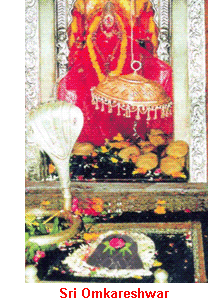 The Omkareshwar is not affixed to the ground, but is naturally installed there. There is always water around it. The significance of this linga is that the linga is not situated below the cupola. The idol of Lord Shiva is situated on the top of the temple. The Omkareshwar is not affixed to the ground, but is naturally installed there. There is always water around it. The significance of this linga is that the linga is not situated below the cupola. The idol of Lord Shiva is situated on the top of the temple. Lord Shiva with Godess Parvati Lord Shiva with Godess ParvatiInstall a new shivling at the Omkareshwar Friday, June 30, 2006 (Khandwa) Amidst controversy over an artificial shivling at Amarnath, authorities in Madhya Pradesh's Khandwa district are planning to install a new shivling at the Omkareshwar Temple following cracks in the original shivling People are angry that repair work was carried out secretly and without the knowledge of the district collector, who is also the chairman of the temple trust. The Temple is one of the 12 Jyotirlings in the world and shivling in these temples are believed to be nature-made. However, cracks were seen about a fortnight ago. Following this, the Temple Trust got the patchwork done about 10 days ago. But it has come off again. The controversy is that the patchwork was done secretly without the knowledge of the Collector, who is the chairman of the Trust. Therefore, the story assumes significance in the light of the Amarnath temple controversy. Minor repairs done After noticing that a small portion of the one-foot-high stone idol had been severed a few days back, temple authorities made certain minor repairs in consultation with the state Archaeology department to facilitate unhindered worship. Though the precise causes for the damage to the Swayambhu (self-emerged) shivling were yet unclear, the district administration said the Jyotirlinga was damaged due to a natural weathering process. Omkareshwar Temple Trust chief priest Swami Tejanand, however, says the Jyotirlinga suffered damage due to continuous rituals and being touched by devotees. "The Trust is seriously considering installation of a new Jyotirlinga after submerging the existing shivling in the holy Narmada some time after August. Swami Jayendra Saraswati of the Kanchi Kamakoti Peetham is being consulted," he explained. Admitting that the damaged idol was not fit for worship, Swami Tejanand pointed out that at Jyotirlingas the place was of greater religious significance than the image. The Jyotirlinga at Someshwar in Gujarat had been replaced some time back, he said, in support of his plan to replace the idol at Omkareshwar. Meanwhile, the Temple Trust is also planning to place a transparent cover over the present shivling till a new one is installed. Sunday, July 2nd, 2006 Bhopal - Offerings of milk, curd, water and other traditional materials on the sacred jyotirlinga at the famous Omkareshwar temple has been with banned to save the phallus-shaped symbol of Hindu lord Shiva from further erosion, officials said Sunday. The Khandwa district administration took the decision Saturday on the advice of the Archeological Survey of India (ASI), the officials said. 'The damage is being caused due to the offerings made on the Shivlinga which is made of sandstone - comparatively soft material,' said ASI deputy superintendent Ashok Kumar Pandey who had inspected the damaged lingam. The jyotirlinga at Omkareshwar, 350 km from here, is one of the 12 major lingams in India and Nepal. 'A crack had been found in the one-foot high shivlinga a few days ago and was repaired using a locally made paste but it did not prove effective,' said Swami Tejanand, chief priest of the Omkareshwar Temple Trust that looks after the temple. 'The jyotirlinga has suffered damage because a large number of devotees touch it every day during rituals,' he said. 'The trust is seriously considering the installation of a new jyotirlinga after submerging the existing Shivlinga in the holy Narmada river some time after August. Swami Jayendra Saraswati of the Kanchi Kamakoti Peetham is being consulted on the issue,' the priest said. However, Khandwa district collector Nikunj Kumar Shrivastava said the administration was consulting the ASI to preserve the lingam and there were no plans to install a new one. Meanwhile, the temple trust is planning to place a transparent cover over the present shivling till a new one is installed   May the sacred Omkareshwar lingam shower his blessings on us and fill our lives with his grace. May the sacred Omkareshwar lingam shower his blessings on us and fill our lives with his grace.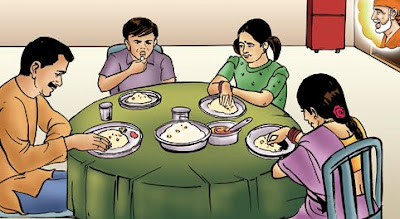 Message from the teachings of Sai baba for 1st December Message from the teachings of Sai baba for 1st DecemberThere shall be no want in the house of My devotees Spiritual values mark the life of a devotee. We must forgive our enemies and love all. Our mind must be freed from thoughts of greed, cruelty, scandal-mongering and selfishness. We must be contented and live in peace, realizing the truth that money cannot buy peace of mind. We must erase our ego and savour the spiritual treasure of dwelling in the Divine Presence of Baba and restrain from getting lured by the worldly pleasures. Nothing will be lacking in the house of a God-conscious devotee. One may lack good health, peace of mind or material riches. Wants are endless and of course multiply upon fulfilling them. Being a slave to wants, man is never content or happy. But Baba's devotees are an exception as they have strong will-power and rock-like faith in His Grace. 'Want' or 'lack' does not bother them as they are aware that nothing can be obtained without His Grace and whatever they really deserve is provided at the right time. They believe that Baba is the ruler of their lives. Irrespective of the onerous responsibilities one has to shoulder, Baba's devotees live without fear or anxiety as they know that whatever will happen will be at His Will and whatever one enjoys is also gifted by God. Hence, Baba, in His Eleventh Divine Assurance, promises: "There shall be no want in the house of My devotees". --------- ---------------------- I firmly believe that I have no say or do in choosing the time and the matter of these messages. They are all inspired by Sai himself and I am simply the media to share these wonderful pictures of teerth Yatra with all of you..May Sai show us all His presence and His leelas by taking us around the world to visit all the sacred shrines thru these teerth Yatras. Gurur Brahma Gurur Vishnu Gurur Devoh Maheshwar; Gurur Shakshat Parambramha Tashmai Shri Gurur Veh Namah" May the Merciful Sri Sai Baba always shower His grace on us and our families and remove our problems and anxieties by giving us all - strength , goodluck, success and happiness with peace of mind. Sai bhakt, Deepa H |
Join our Group today
Click at our Group address :
http://groups.google.co.in/group/shirdikesaibaba
Current email address :
shirdikesaibaba@googlegroups.com
Also visit us at :
http://shirdikesaibabaji.blogspot.com

